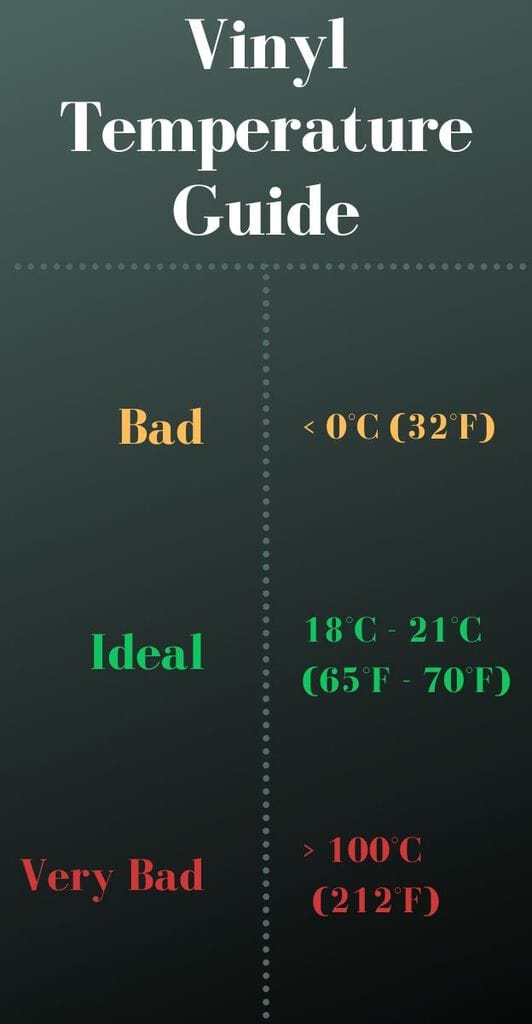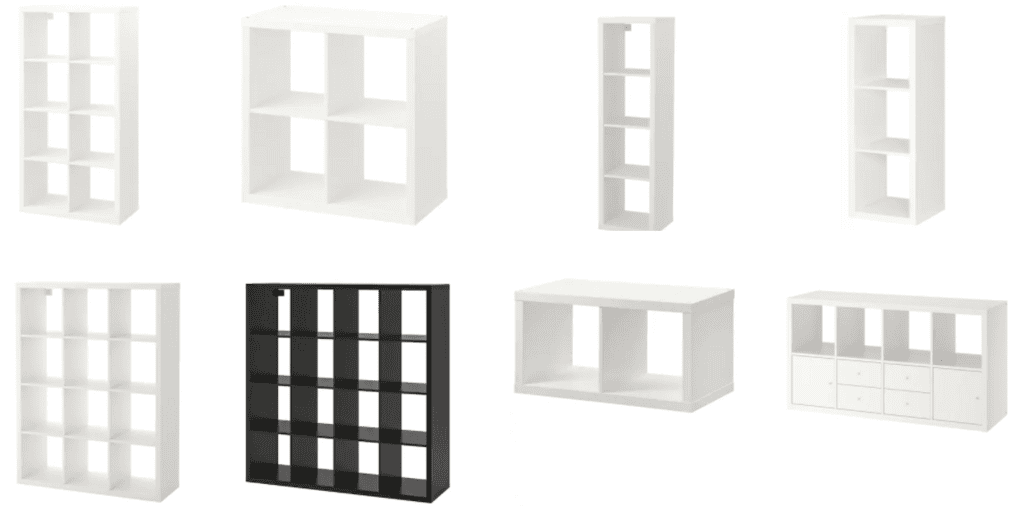- Store the vinyl records at temperatures between 65°F (18°C) and 70°F (21°C).
- Don’t store records in a moist location.
- Store the records high and dry.
- Arrange the LPs vertically, as close to 90 degrees as possible.
- Cover your vinyl with plastic sleeves and don’t overstuff, to prevent ringwear.
In this article I’m going into detail about the best way to store vinyl records. I’ll first get into the ideal temperature. Then I’ll cover where you want to store them in your house. After that the furniture they should be stored in. Then the best arrangement of the records themselves and the issue of ringwear. Finally I’ll get into how to prevent dust accumulation and some long term storage tips.
The topics aren’t ordered in any particular order.
Table of Contents
What Temperature Should Records Be Stored At
Vinyl records should be stored at room temperature. You can’t store records below the freezing point, because it will increase the chance of breaking. You can’t store vinyl at high temperatures, because it will cause warping. Direct sunlight should be avoided.
Heat is the real risk here, which can sneak up on you. If the vinyl records are left in the sun for too long, or inside a car, and they can get too hot very quickly, which causes warping. This is considered the biggest threat to vinyl records.
Take a look at my complete temperature guide for vinyl. (opens in a new tab)

Where Should I Store Vinyl Records
The best place to store vinyl records is in your study or living room. Avoid too hot places like the attic. Also avoid damp and cold places like the garage or basement. Ideally use a room with enough space, in height as well, because you want to store your records high and dry.
Again heat should be avoided at all costs. So if you have to choose between the attic or your basement choose the basement, especially if you live in a hot area. But be very careful if your basement is too damp, because mold can also quickly ruin your records.
For long term storage you could consider temperature controlled storage units, but I’ll elaborate on that later in the article.
What Should I Store Records In
Vinyl records should be stored inside sturdy furniture. The ideal furniture is compartmentalized to divide the weight of the records. It’s also important that it allows to store the vinyl off of the ground, especially in a basement because of leakages and floodings. Make sure there’s enough space so you don’t have to stuff in records.
In vinyl collector Facebook groups I discovered the Ikea Kallax is a very popular piece of furniture for this. The Kallax series has a lot of options and prices range from $30 to $200.

Personally I use album racks from https://www.boltz.com, but these can get very expensive so actually I recommend getting one of the very popular Ikea Kallax pieces.
Regarding milk crates, these are also a pretty popular option. But regular milk crates aren’t ideal for long term storage, because they aren’t sturdy enough and will sag in time. The rounded edges can also be dangerous. However there are crates made specifically for vinyl records now, so these can be a nice option for temporary storage.
Store Vinyl Records Horizontally or Vertically
Vinyl records should be stored vertically, so upright and side by side. Strive for 90 degrees because deviation from that puts unwanted weight on one end of the row of records. Also don’t overstuff the records to prevent unwanted pressure.
A few degrees off-center won’t destroy your collection, especially when using a compartmentalized piece of storage furniture. This is because each stored section only has its own weight to deal with. So don’t obsess over the 90 degrees, just make sure it’s somewhat close to 90 degrees for long term storage.
Stacking or horizontal storing is a bad idea, because it will put weight and stress on the flat records below which causes warping and ringwear. Don’t forget to have the records inside plastic sleeves.
How To Prevent Ringwear On Record Albums
Ringwear is the ring shape of vinyl records imprinted on their album covers. It’s caused by overstuffing record albums in storage, which will press the vinyl into the cover. Ringwear is also caused by stacking record albums.
To prevent ringwear on album covers you should store records side by side and make sure they aren’t overstuffed and the records aren’t pressing into their album cover. A proven technique is storing the sleeved record and album cover separately in another plastic cover.
How To Prevent Dust In Stored Vinyl Records
To prevent dust from getting into your vinyl records and their grooves make sure the records are inside plastic sleeves. Then store these inside their album covers.
If you want to take this a step further, you can also cover the album covers with an album cover sleeve. That is overkill for dust prevention, but will prevent other damage from happening, which would actually be the main reason to add that third layer of protection.
Find out how to remove dust from your vinyl records here. (opens in a new tab)
How To Store Vinyl Records Long Term
To store vinyl records long term make sure they’re stored at room temperature and preferably stored high and dry. Store them vertically, as close to 90 degrees as possible, in plastic sleeves. Finally you can use climate controlled storage units for controlled temperatures and moisture.
Temperature controlled storage units have a monthly cost of $75 to $225, depending on the unit size. They are ideal for long term storage because of consistent temperature and humidity levels. However consider the extra cost and inaccessibility, because they’re not stored in your home.
So as a summary: to properly store vinyl records make sure they’re stored at temperatures between 65°F (18°C) and 70°F (21°C). Then make sure they’re not in a moist location and preferably stored high and dry. Finally store them vertically, as close to 90 degrees as possible, in plastic sleeves without stuffing to prevent ringwear.
This article covered all I know and have found out about vinyl record storage. If it was helpful, or if you have any questions, you can leave a comment and I’ll reply as fast as possible.
Now that you know how to store your collection I suggest you take a look at another article I wrote about the biggest threats to your vinyl records if you hadn’t already.
Sources
- Storage unit costs: https://move.org/storage-units-cost
- Academy Records & CDs in NYC: http://academy-records.com
- Steven Smith, Human Head Records in NYC: http://humanheadnyc.com
No responses yet